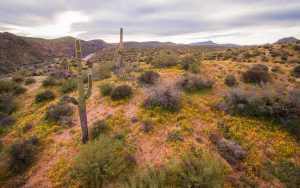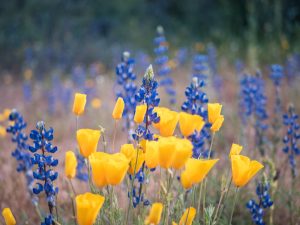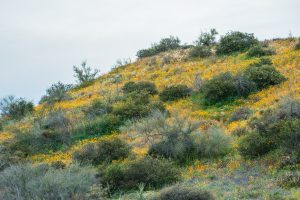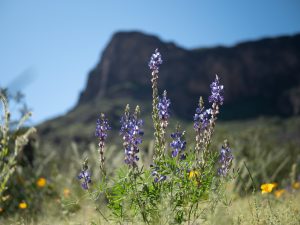- Slug: BC-CNS-Wildflower Season. 590 words.
- 5 photos and captions below.
- Drone video by Jordan Evans here.
By CARISSA WIGGINTON
Cronkite News
PHOENIX – Blankets of bright orange poppies and deep purple lupine cover the rugged hills and mountains at Picacho Peak State Park. Visitors have been flocking there to be dazzled by the flower-coated landscape, which is just a part of this year’s wildflower explosion across the Sonoran Desert.
At Picacho Peak, about halfway between Phoenix and Tucson, the bloom is the best it has been in 15 years, said Michelle Thompson, chief of communications for Arizona State Parks and Trails. Visitation at the park over the past few weekends has almost tripled compared with this time last year.
“It’s been quite awhile, just in general, since we’ve seen such a vast quantity of the flowers in the parks. That just makes those beautiful orange blankets all over the hills and the mountains look so gorgeous,” Thompson said. “You can see them from every trail.”
Everything right happened this year to get the spectacular bloom, said Juliet Stromberg, plant ecologist and emeritus professor at Arizona State University. The combination of a wet fall and winter, with precipitation beginning in October, and lower temperatures created an unprecedented bloom across most of desert Arizona.
Phoenix, for example, had its wettest October in history last year, with more than 5 inches of rain, according to the National Weather Service. That cool, wet weather has hung around, keeping moisture in the ground much longer than usual, Stromberg said.
This bloom has been unprecedented, she said.
“I’ve seen things growing together that I have never seen grown together in my 30 years of living here,” Stromberg said. “We have a summer poppy and a winter poppy, and I was seeing the summer and winter poppies growing side by side. I’ve never seen this particular combination and sequence of plants. It’s just like, ‘Wow, I’ve wanted to see this plant for so long and there it is.’”
The rainfall-temperature combination set the stage for California and Mexican poppies, lupine, scorpionweed and globemallow to burst open across the desert, Stromberg said. Also making appearances this year are California suncup, Gilia, trailing 4 o’clocks, Arizona jewelflower, fiddlenecks and owl’s clover.
“The timing of the first major rainfall that kicked off the blooms, happening in October, was kind of an atypical period,” she said. “Then following that, we had the cooler rains. We’re in an El Niño cycle, so we’re having frequent rains that just kept everything going.”
Angelica Elliott, assistant director of public horticulture at the Desert Botanical Garden, said it has been some time since the Sonoran Desert has seen such huge numbers of wildflowers.
“These seasons where we have these spectacular blooms don’t happen every year,” Elliott said. “It’s been over 10 years since we’ve seen this type of wildflower display.”
With the lower temperatures came successive nights of freezing, which can impact the wildflowers, Elliott said. But she said those cold nights earlier this year didn’t damage the flowers.
“I was driving out to Superstition Mountains, and I looked out along the roadside and it was just covered with purple lupine,” she said. “Even down in the Safford area, you’ll see mountains ablaze with orange – that’s the poppies blooming. It’s been a good year and the freezing temperatures haven’t seemed to be an impact.”
The wildflower season may last through May, Thompson said. Oracle State Park near Tucson and Red Rock State Park near Sedona are expected to have wonderful blooms, too. The parks are slightly higher in elevation, so flowers there haven’t quite opened up their petals to show off their springtime color.
Have a story idea? Email us at cronkitenews@asu.edu.
For more stories from Cronkite News, visit cronkitenews.azpbs.org.
^_=




